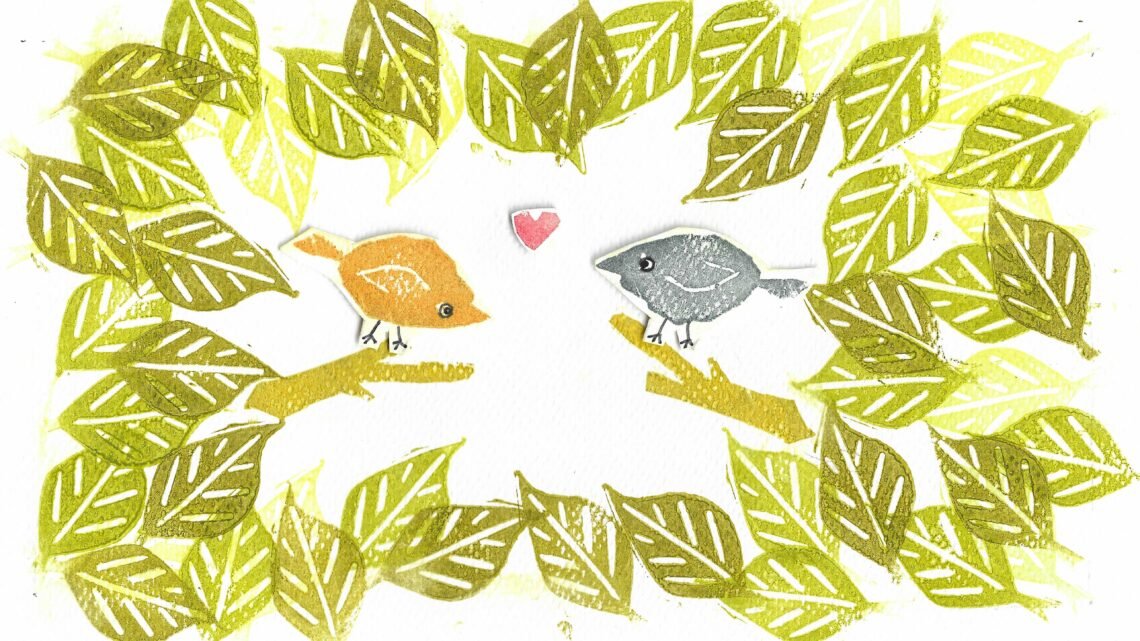To Create a New Generation
Spreading genes is a fundamental part of existence on Earth. For many organisms, it is the very essence – producing offspring and continuing the cycle of life. Although it might sound simple, finding a suitable partner is not always easy. Over hundreds of thousands of years, species have evolved strategies to select the right partners by displaying desirable traits and making use of their surroundings to reproduce successfully.
If we pay attention, these strategies become apparent. At certain times of the year, while walking through a park, birds start singing more than usual. We hear it as beautiful serenades – nature’s music. But for the birds, these songs are often a call for sex. In most species, males sing to attract females and they must do so impressively to gain their attention.
However, singing alone is not enough – males must also be creative. The song needs to be tailored to the recipient. Sierro et al. (2023) showed that in blue tits (Cyanistes caeruleus), females prefer songs containing repetitive notes but are not impressed by the simple repetition of entire songs. To attract females, males need to display a diverse repertoire of songs that include repetitive notes.
Singing is not the only way birds attract partners – movement also plays a crucial role. Many species have developed elaborate dance routines as part of their courtship displays. In the documentary series Our Planet (Fothergill & Hughes, 2019), we can observe the remarkable dances of manakins – a family of birds inhabiting the tropical forests of the Americas, from Mexico to northern Argentina. These birds take courtship very seriously, however, there is considerable variation among species. Blue manakins (Chiroxiphia caudata), for instance, practice their dance routines in groups, taking advantage of teamwork. Younger males assist older ones in performing and attracting a female. Golden-collared manakins (Manacus vitellinus), on the other hand, perform spectacular backflips from one branch to another. Imagine if humans had to perform backflips to impress their dates!
One might wonder what the point of singing and dancing is – these are not practical skills for survival in the wild. You can’t get food or fight predators with a song. Shouldn’t females be more attracted to traits that are useful, such as strength or fighting ability? Apparently not. Snow et al. (2025) showed that in greater sage-grouse (Centrocercus urophasianus), females are not interested in the most aggressive males. Instead, they prefer the best dancers. Perhaps there’s a lesson to be learned from them.
Nevertheless, singing and dancing are not just for show – they demonstrate a bird’s overall fitness. Zahavi (1975) introduced the concept of the “handicap principle”, which proposes that costly traits or behaviors serve as reliable signals of genetic quality. The precision and effort required for synchronized, energy-demanding performances indicate motor control, strength, and stamina. Only males in excellent condition can afford to perform so intensely without attracting predators or exhausting their energy reserves.
Such elaborate reproduction efforts are not limited to the animal world. Although we might not think about it, plants also reproduce, and their methods are equally intricate. Many depend on animals for assistance: birds and bees transport pollen from one flower to another, enabling gene transfer. We might not realize it, but the tiny pollen grains represent the male gametes that fertilize the female gamete in the ovule. Later, a fruit develops enclosing seeds that will give rise to the next generation.
Forget about romance – some plants need far more extreme conditions to reproduce, even going as far as requiring fire. A group of plants has evolved not only to withstand fire but also to use it to their advantage. Lamont and He (2017) highlighted that pines have been associated with fire-prone environments since their origins more than 140 million years ago. One group of plants that has retained this fire-dependent strategy is the world-famous giant sequoias. These enormous trees – which can reach up to 90 meters in height – are serotinous conifers, meaning their cones remain sealed until heat causes them to open and release their seeds (Lamont & He, 2017). To put it simply, the seed chambers of a pinecone are sealed with natural glue, and only the heat of a wildfire can melt it, allowing the seeds to be released.
Nature has an extraordinary ability to adapt and evolve. From a human-centered perspective, wildfires are often seen as disasters. While human societies are not well adapted to them, for some organisms, wildfire is essential for giving rise to the next generation. Without wildfires, sequoias would not regenerate – paradoxically, we need wildfire if we want new trees to grow (Hanson et al. 2024). These trees are like a phoenix, rising from the ashes to begin new life.
However, not all fire is good fire. Keeley et al. (2011) pointed out that some species “are not adapted to fire per se but to fire regimes.” Wildfires are naturally occurring events only in certain ecosystems (e.g., savannas or conifer forests). Yet, with climate change, the balance of these forces has been disrupted. Fires that occur too frequently or burn too intensely are no longer beneficial – they can be devastating for ecosystems and biodiversity.
The drive to spread genes connects all living things, from birds to trees. But success doesn’t come easy. It requires proper song or dance, the right surrounding, and many other factors falling into place at the exact right time. These complex demands require remarkable solutions. Good thing each organism has found its own astonishing way to face these challenges and secure its part of DNA for generations to come.
References:
Fothergill, A. (Director), & Hughes, K. (Producer). (2019). One planet (Season 1, Episode 1) In Our planet. Silverback Films; Netflix. https://www.netflix.com/title/80049832
Hanson, C. T., Chi, T. Y., Baker, B. C., Khosla, M., & Dorsey, M. K. (2024). Postfire reproduction of a serotinous conifer, the giant sequoia, in the Nelder Grove, California. Ecology and evolution, 14(4), e11213. https://doi.org/10.1002/ece3.11213
Keeley, J. E., Pausas, J. G., Rundel, P. W., Bond, W. J., & Bradstock, R. A. (2011). Fire as an evolutionary pressure shaping plant traits. Trends in plant science, 16(8), 406–411. https://doi.org/10.1016/j.tplants.2011.04.002
Lamont, B. B., & He, T. (2017). Fire-Proneness as a Prerequisite for the Evolution of Fire-Adapted Traits. Trends in plant science, 22(4), 278–288. https://doi.org/10.1016/j.tplants.2016.11.004
Sierro, J., De Kort, S. R., & Hartley, I. R. (2023). Sexual selection for both diversity and repetition in birdsong. Nature Communications, 14(1). https://doi.org/10.1038/s41467-023-39308-5
Snow, S. S., Patricelli, G. L., Butts, C. T., Krakauer, A. H., Perry, A. C., Logsdon, R., & Prum, R. O. (2025). Fighting isn’t sexy in lekking greater sage-grouse: a relational event model approach for mating interactions. Proceedings of the Royal Society B Biological Sciences, 292(2047). https://doi.org/10.1098/rspb.2024.2981
Zahavi, A. (1975). Mate selection—A selection for a handicap. Journal of Theoretical Biology, 53(1), 205–214. https://doi.org/10.1016/0022-5193(75)90111-3

Norbert Borski is a first-year Master’s student in Biomedical Sciences with a specialization in Oncology at UvA. He completed his Bachelor’s in Biology in Cracow, Poland, and then traveled through South America before settling in Amsterdam. Besides spending time in the lab, he is passionate about exploring new cultures, traveling, and learning languages. In his free time, he enjoys creating art through pottery, painting, and writing, as well as appreciating art through film and theater.

Merel Hamminga is currently in her last year of the Master Clinical Neuropsychology at the University of Amsterdam. She did her bachelor in Psychobiology, but made the step towards Psychology because she thought she didn’t want to go in the scientific direction. In the end, she is no longer sure about that and would like to combine psychology and science in a future job. In her free time, she enjoys a good book, playing tennis and nature (especially birds). But most of all, she likes drawing, crafting or being creative.
